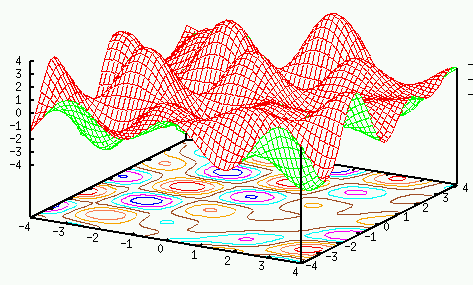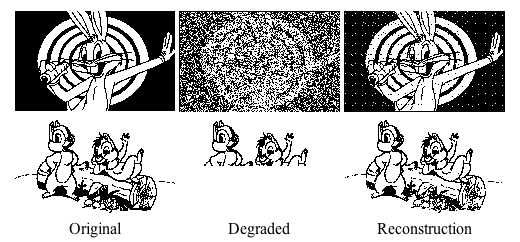Next: Perceptron Up: ch10 Previous: Hebbian Learning
The Hopfield network
is a supervised method, based on the Hebbian learning rule. As a
supervised method, the Hopfield network is trained based on a set
of 
![${\bf X}=[{\bf x}_1,\cdots,{\bf x}_K]$](img76.svg)
![${\bf x}_k=[x_1,\cdots,x_d]^T$](img77.svg)






Structurally, the Hopfield network is a recurrent
network, in the sense that the outputs of its single layer of 

The training process is essentially the same as the Hebbian learning,
except here the two associated patterns in each pair are the same
(self-association). The weight matrix of the network is obtained as
the sum of the outer-products of the 
![$\displaystyle {\bf W}_{d\times d}=\frac{1}{d}\sum_{k=1}^K {\bf x}_k {\bf x}_k^T...
...k)} \\ \vdots \\ x_d^{(k)} \end{array} \right]
[ x_1^{(k)}, \cdots, x_d^{(k)} ]$](img80.svg) |
(20) |
 |
(21) |

Once the weight matrix 

 |
(22) |
 and
and
 are the output
are the output  of the ith node
before and after the nth iteration, respectively. As shown below, this
iteration will always converge to one of the
of the ith node
before and after the nth iteration, respectively. As shown below, this
iteration will always converge to one of the  pre-stored patterns.
pre-stored patterns.
We first define the Energy function of any two nodes 


 |
(23) |
 nodes in the network as the sum
of all pair-wise energies:
nodes in the network as the sum
of all pair-wise energies:
 |
(24) |
The interaction between these two nodes is summarized below:
 |
(25) |
 :
:
 (in cases 1 and 4),
(in cases 1 and 4),  tends to
keep
tends to
keep  to stay at the same state
to stay at the same state  in the iteration.
in the iteration.
 (in cases 2 and 3),
(in cases 2 and 3),  tends to
keep
tends to
keep  to stay at the same state
to stay at the same state  .
.
 :
:
 (in cases 1 and 4),
(in cases 1 and 4),  tends to
reverse
tends to
reverse  from its previous state
from its previous state  to
to  .
.
 (in cases 2 and 3),
(in cases 2 and 3),  tends to
reverse
tends to
reverse  from its previous state
from its previous state  to
to  .
.
 corresponds to a stable interaction
between
corresponds to a stable interaction
between  and
and  , i.e., they tend to remain unchanged, and high
energy corresponds to an unstable interaction, i.e., they tend to change
their states. As the result, low total
, i.e., they tend to remain unchanged, and high
energy corresponds to an unstable interaction, i.e., they tend to change
their states. As the result, low total
 corresponds
to more stable condition of the network, while high
corresponds
to more stable condition of the network, while high
 corresponds to less stable condition.
corresponds to less stable condition.
We further show that the total energy







 |
 |
![$\displaystyle -\frac{1}{2}
\left[ \sum_{i\neq k}\sum_{j\neq k}w_{ij}x_i^{(n)}x_j^{(n)}
+\sum_i w_{ik}x_i^{(n)}x_k^{(n)}+\sum_j w_{kj}x_k^{(n)}x_j^{(n)} \right]$](img106.svg) |
|
 |
 |
 changes state is
changes state is
 |
(26) |
 |
(27) |
 , but
, but
 and
and
 , we have
, we have
 and
and
 .
.
 , but
, but
 and
and
 , we have
, we have
 and
and
 .
.
 is always
true throughout the iteration, we conclude that
is always
true throughout the iteration, we conclude that
 will
eventually reach one of the minima of the energy landscape, i.e.,
the iteration will always converge.
will
eventually reach one of the minima of the energy landscape, i.e.,
the iteration will always converge.


We further show that each one of the 


 |
(28) |
 different (ideally orthogonal to) from any of the stored
patterns, all
different (ideally orthogonal to) from any of the stored
patterns, all  terms of the summation will be small (ideally zero).
But if
terms of the summation will be small (ideally zero).
But if  is the same as any one of the stored patterns, their
inner product reaches maximum, causing the total energy to be minimized
to reach one of the minima. In other words, the patterns stored in the
network correspond to the local minima of the energy function. i.e.,
these patterns become attractors.
is the same as any one of the stored patterns, their
inner product reaches maximum, causing the total energy to be minimized
to reach one of the minima. In other words, the patterns stored in the
network correspond to the local minima of the energy function. i.e.,
these patterns become attractors.
Note that it is possible to have other local minima, called spurious states, which do not represent any of the stored patterns, i.e., the associative memory is not perfect.
